Time blocking is a powerful productivity strategy that can transform your student life. By dedicating specific blocks of time to focus on tasks, you can enhance your efficiency and effectiveness in studying, completing assignments, and managing your academic workload.
What is Time Blocking?
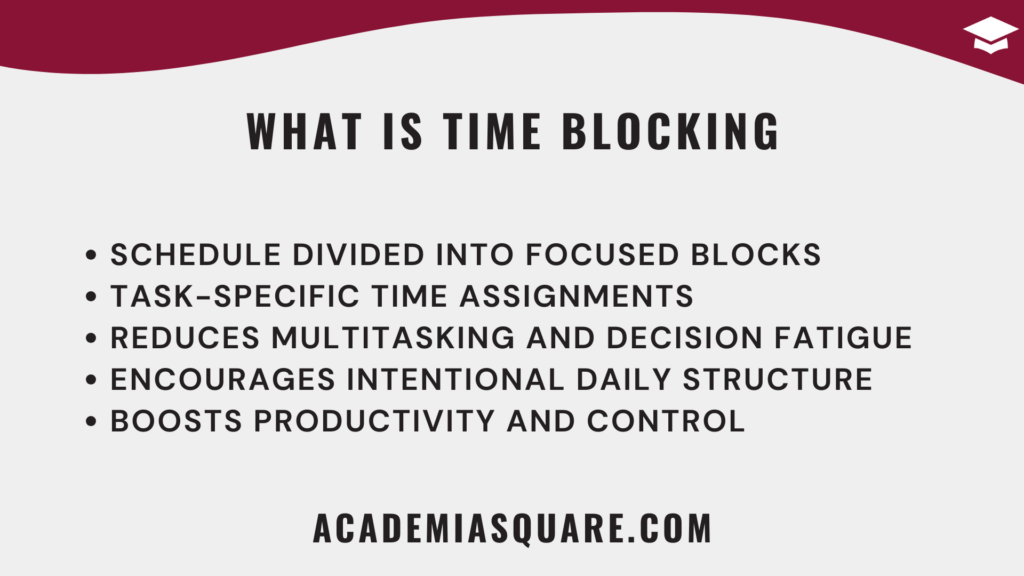
Time blocking is a productivity technique that involves scheduling specific periods of time to focus exclusively on a particular task or group of tasks. Instead of multitasking or allowing distractions to interrupt your workflow, you allocate dedicated blocks of time to work on one thing at a time. This structured approach not only helps in managing your time effectively but also enhances concentration and overall productivity.
When implementing time blocking, you create a systematic timetable where each block is dedicated to a specific activity. For example, you might allocate a block of time in the morning for reading and note-taking, followed by another block in the afternoon for writing essays or preparing for exams.
This method encourages deep work by allowing you to immerse yourself fully in the task at hand during each designated time block. By segmenting your day into focused intervals, you establish a predictable routine that reduces procrastination and improves your ability to stay on task.
Key benefits of time blocking include:
- Enhanced productivity by focusing on one task at a time, reducing the cognitive load associated with switching between tasks.
- Reduced distractions and interruptions, leading to improved efficiency and higher quality work output.
- Improved time management skills as you learn to allocate time based on task priority and deadlines.
- Encouragement of efficient use of study time, ensuring that each block is dedicated to meaningful progress towards academic goals.
- Boosted concentration and mental clarity by providing dedicated periods for focused work, leading to deeper understanding and retention of information.
Implementing time blocking requires careful planning and discipline, but the rewards are substantial. It’s a flexible strategy that can be customized to fit your unique schedule and academic objectives, making it an invaluable tool for students striving to maximize their potential and achieve academic success.
How to Implement Time Blocking in Your Study Routine
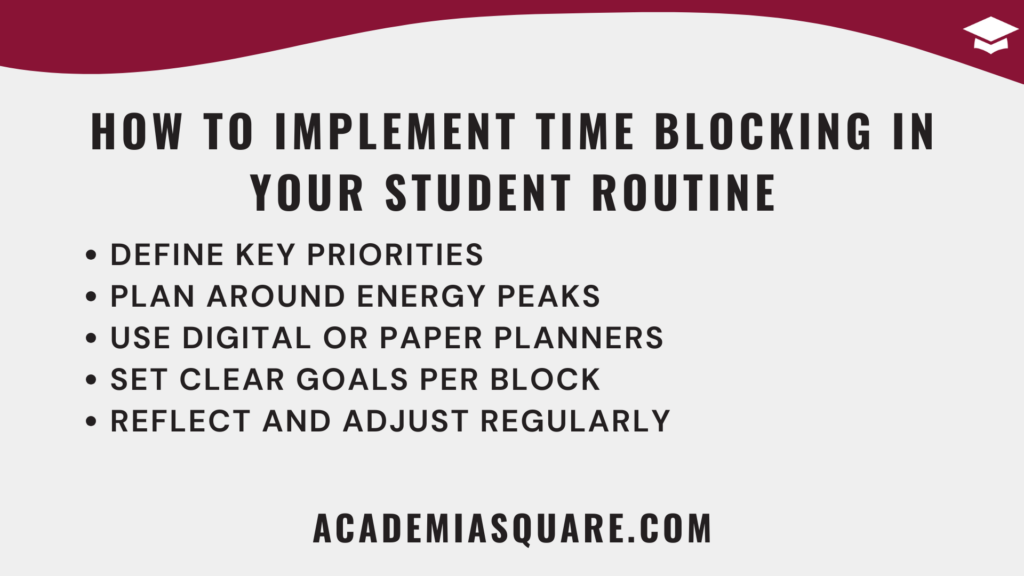
To successfully integrate time blocking into your study routine, you’ll need a combination of strategy, self-awareness, and consistency. This powerful productivity technique can help you structure your day with purpose, improve focus, and reduce procrastination. Here’s a step-by-step guide to get started:
1. Identify Your Priorities
Begin by clearly defining your academic goals and responsibilities. Ask yourself: What tasks are non-negotiable? What subjects require the most effort? Consider upcoming deadlines, ongoing assignments, exam preparation, reading requirements, and personal development goals. Categorizing tasks into “high priority,” “medium priority,” and “low priority” can help you allocate time more effectively.
2. Audit Your Current Time Usage
Before you start time blocking, spend a few days tracking how you currently spend your time. Use an app or simple journal to log your activities. Identify time drains (e.g., excessive social media, passive entertainment) and underutilized slots in your schedule. This audit will provide a realistic foundation for designing your new routine.
3. Design a Custom Daily Schedule
Now that you understand your priorities and time availability, design a schedule with clear, intentional time blocks. Break your day into segments of 30 to 90 minutes dedicated to specific tasks. Consider using tools like Google Calendar, Notion, or physical planners. Be sure to account for fixed activities (like lectures or part-time jobs), and block in buffer time between tasks to reduce stress and prevent burnout.
4. Match Tasks with Your Energy Levels
Identify when you feel most alert and productive — your “peak hours.” Schedule your most mentally demanding tasks (like problem-solving or writing essays) during these high-energy periods. Reserve lighter tasks (like reviewing flashcards or organizing notes) for times when your energy dips. This alignment can drastically improve the efficiency of your study sessions.
5. Set Clear Goals for Each Block
For every block of time, define exactly what you plan to achieve. Avoid vague intentions like “study history.” Instead, write down specific goals such as “review chapters 3–4 and complete quiz questions.” This clarity keeps you focused and allows you to track your progress more easily throughout the day.
6. Minimize Distractions
Treat your time blocks as protected sessions. Silence your phone, close irrelevant browser tabs, use apps like Forest or Focus Mode, and inform others of your study periods. Choose a quiet, organized environment that supports concentration. Consistency in minimizing distractions will build mental discipline over time.
7. Build in Breaks and Flexibility
Don’t forget to schedule short breaks between blocks to rest and recharge — ideally 5 to 15 minutes for every 45–60 minutes of work. Include longer breaks for meals and relaxation. Leave room for flexibility to accommodate unexpected changes or emergencies without throwing your entire schedule off track.
8. Review and Adjust Regularly
At the end of each day or week, reflect on what worked and what didn’t. Were your blocks realistic? Did you meet your goals? Which distractions broke your flow? Use this feedback to fine-tune your schedule, shift blocks around, or update task priorities. Over time, you’ll create a study system that is both structured and adaptive.
By implementing these strategies, you can harness the power of time blocking to optimize your study habits, maintain consistency, and make meaningful progress toward your academic goals.
Time Blocking Methods
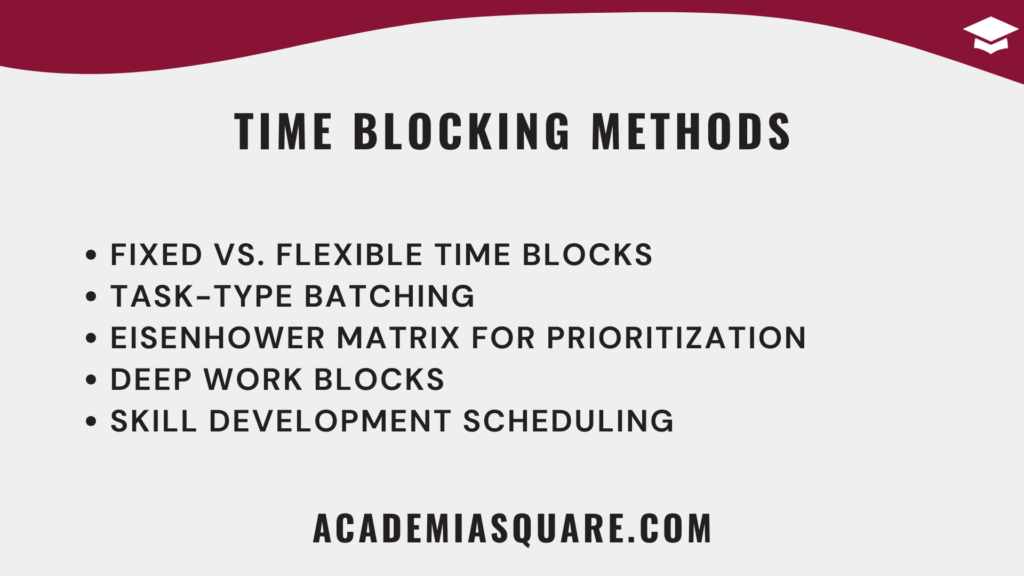
When exploring time blocking methods, it’s essential to find the approach that best suits your schedule, energy cycles, and study habits. No single method works for everyone, so experimentation is key. Below are some proven techniques that students and professionals alike have found effective, supported by behavioral science and productivity research.
Fixed Time Blocks
This method involves assigning specific, unchanging time slots to recurring tasks — for example, studying from 9–11 AM every weekday or reviewing notes from 4–5 PM daily. Fixed time blocks work best for individuals who thrive on routine and want to develop consistent habits. According to research published in *Nature Human Behaviour*, habit formation benefits greatly from predictable cues and rewards — meaning that regular, fixed time blocks can hardwire positive study habits over time.
Additionally, a 2020 study by the American Psychological Association (APA) found that structured schedules are linked to reduced cognitive fatigue and higher task follow-through rates. The key to success with this method is discipline and protecting those blocks as sacred, non-negotiable commitments in your calendar.
Flexible Time Blocks
This approach allows for dynamic adaptation of your schedule based on daily or weekly changes in responsibilities, deadlines, or energy levels. It’s ideal for students juggling irregular commitments like part-time jobs, group projects, or shifting class times. Flexibility doesn’t mean lack of structure—it means your structure adapts intelligently.
Flexible blocking is often supported by techniques like “time tracking” and “rolling planning,” where you review your goals each morning or week and slot tasks accordingly. A Harvard Business Review article on adaptive productivity suggests that individuals who routinely adjust their schedule based on new data outperform those who rigidly stick to plans when environments change.
The Eisenhower Matrix
The Eisenhower Matrix (popularized by former U.S. President Dwight D. Eisenhower) divides tasks into four quadrants: Urgent and Important, Important but Not Urgent, Urgent but Not Important, and Neither. This method can be layered onto time blocking to determine what deserves a block in the first place.
Research in time management education, especially by Stephen Covey (author of *The 7 Habits of Highly Effective People*), supports this model for prioritizing long-term academic success. For example, allocating blocks to “Important but Not Urgent” tasks — like early exam prep or research planning — helps prevent the chronic last-minute stress trap.
Time Blocking by Task Type
This technique, known as “task batching,” groups similar tasks into shared blocks to minimize cognitive switching. For example, create a block for reading, one for essay writing, and one for peer discussions or tutoring. Task switching is shown to reduce efficiency by up to 40%, according to a study by the American Psychological Association.
By focusing on one type of cognitive activity at a time, your brain uses less energy reorienting itself and more energy actually executing the task. This method is especially effective for tasks that require flow-state engagement, such as academic writing or mathematical problem-solving.
Time Blocking with Breaks
Incorporating rest into your schedule is not optional—it’s a performance enhancer. The Pomodoro Technique is a well-known example, involving 25 minutes of focused work followed by 5-minute breaks, with a longer 15–30 minute break after four cycles. Neuroscience research from the University of Illinois confirms that brief diversions can improve focus, as the brain naturally begins to tune out constant stimulation over time.
Longer study blocks (e.g., 60–90 minutes) may be suitable for deep work, but even these should include strategic breaks to maintain peak mental function. Break activities like walking, stretching, or meditating have been shown to restore attention and improve memory consolidation.
Priority-Based Time Blocking
This method aligns your schedule with task importance and urgency. Before creating blocks, prioritize your to-do list using techniques like the ABCDE method (popularized by Brian Tracy) or Ivy Lee’s method (limiting to 6 key tasks/day). Then assign blocks based on the weight of each task.
By leading with priority — not just time availability — you ensure that the most meaningful work gets done first. According to a study in the *Journal of Behavioral Decision Making*, people who prioritize high-impact tasks report higher levels of satisfaction and reduced stress compared to those who focus on low-effort or urgent but less meaningful activities.
Time Blocking for Deep Work
Coined by Cal Newport, “deep work” refers to focused, undistracted sessions where cognitively demanding tasks are tackled — like writing a thesis, solving complex equations, or synthesizing research. These sessions should be at least 60–120 minutes long, uninterrupted, and ideally occur during your personal peak productivity windows.
Research from Stanford University shows that multitasking can reduce IQ by up to 15 points during high-focus tasks, making deep work essential for real academic breakthroughs. Tools like “do not disturb” modes, noise-canceling headphones, and website blockers (like Cold Turkey or Freedom) support this kind of time block.
Time Blocking for Skill Development
Whether you’re learning a second language, coding in Python, or improving your academic writing, skill development requires deliberate, consistent effort. Block off time weekly for targeted skill-building — even just 30 minutes a day can yield compound results.
The theory of “deliberate practice,” as studied by psychologist K. Anders Ericsson, suggests that consistent, focused effort on stretch goals (just beyond your current ability) is what leads to mastery. Schedule blocks with specific objectives — not “practice guitar,” but “learn F chord transitions for 20 minutes.”
Experiment with these time blocking methods to discover which aligns best with your personality, workload, and learning style. You may find a hybrid approach — such as combining fixed blocks with priority-based planning — is the most effective. The key is to keep adapting your strategy as your academic demands evolve.
Tools and Apps for Effective Time Blocking
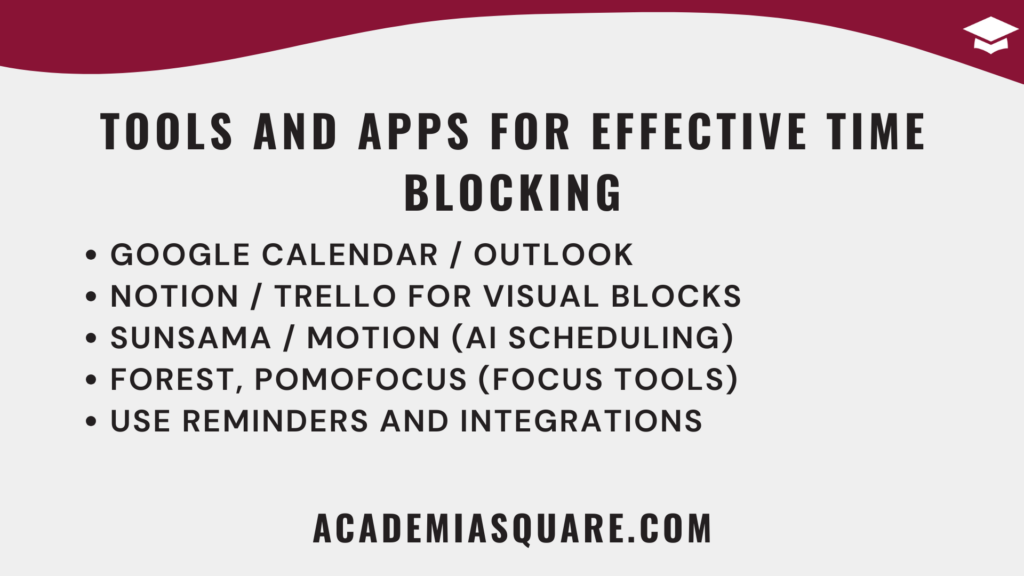
In today’s digital age, numerous tools and apps can support your time blocking efforts. These tools offer features such as scheduling, task management, and productivity tracking to streamline your study sessions. Here are some recommended tools:
1. Todoist: A versatile task management app that allows you to create detailed to-do lists and schedule tasks into time blocks.
2. Google Calendar: An intuitive calendar tool that lets you create events and time blocks, set reminders, and sync across devices.
3. Toggl Track: A time tracking app that helps you analyze how you spend your time during each time block, providing insights into your productivity.
4. Forest: An app that uses gamification to encourage focus and concentration during time blocks by growing virtual trees.
5. Focus Booster: A Pomodoro timer app that divides your study sessions into time blocks (Pomodoros) with breaks in between, enhancing productivity and focus.
Choose a tool or combination of tools that best meets your needs and integrates smoothly into your study routine. These resources can significantly enhance your ability to implement and maintain effective time blocking strategies.
Advantages of Time blocking for Students
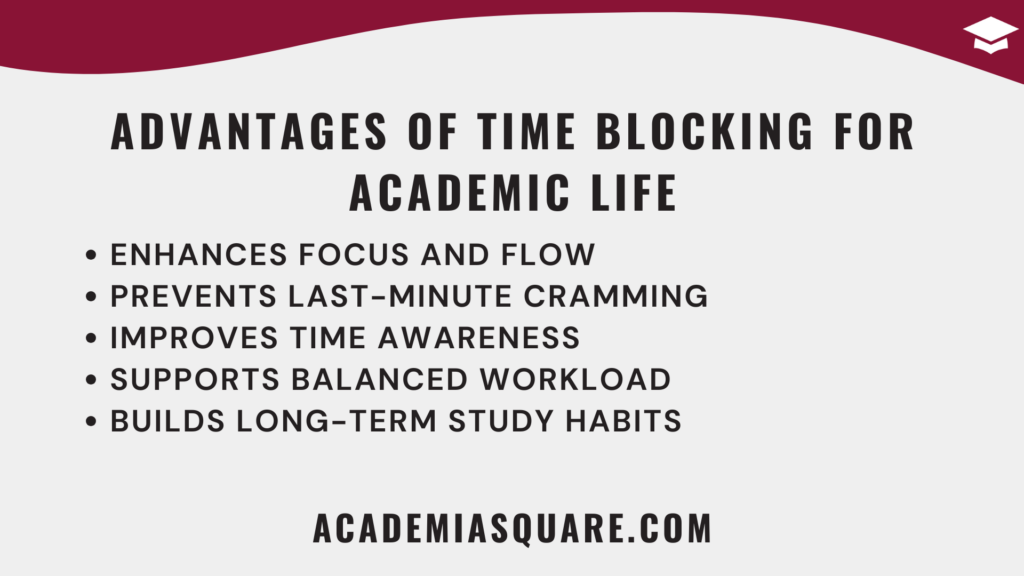
Time blocking for academic life offers a wide range of advantages that significantly improve productivity and overall academic performance:
- Improved Focus: By allocating specific time blocks to tasks, students can minimize distractions and maintain concentrated efforts on their studies.
- Effective Time Management: Planning your day with time blocks helps you allocate sufficient time to different subjects, assignments, and extracurricular activities, ensuring all tasks are completed in a timely manner.
- Reduced Procrastination: Structured time blocks provide a clear schedule and deadlines for tasks, reducing the tendency to delay important assignments or study sessions.
- Enhanced Productivity: Breaking down academic tasks into manageable time blocks allows students to work efficiently and systematically, achieving more in less time.
- Improved Work-Life Balance: By organizing study time effectively, students can create dedicated periods for relaxation, hobbies, and social activities, promoting a healthy balance between academic and personal life.
Additionally, time blocking encourages students to prioritize tasks based on importance and deadlines, ensuring that critical assignments receive adequate attention and are completed successfully.
Time blocking also enhances accountability, as students set specific goals and deadlines for each time block, motivating them to stay focused and productive throughout the day.
The structured approach of time blocking fosters discipline and consistency in study habits, helping students develop effective time management skills that are essential for academic success.
Why is Time blocking So Effective?
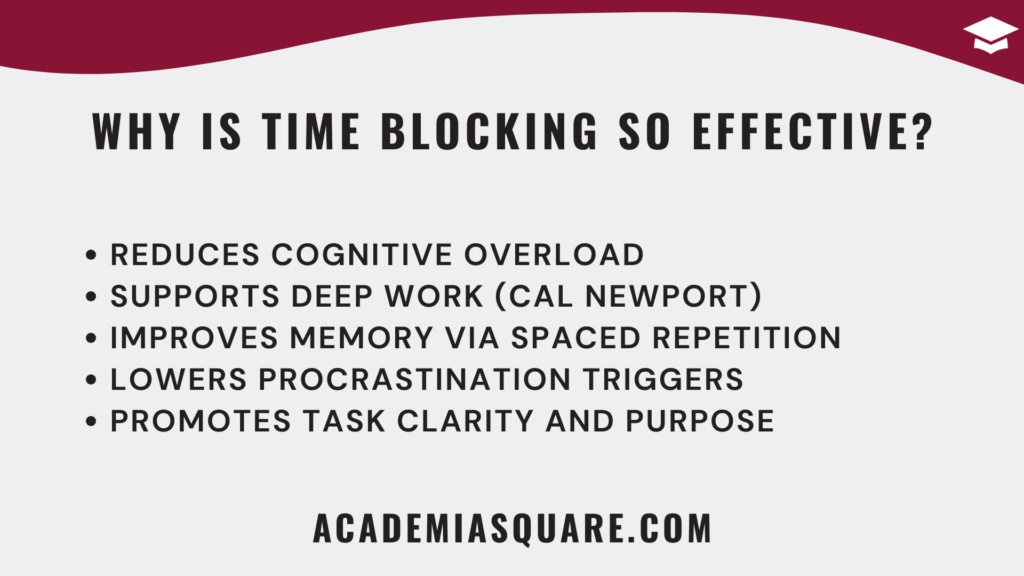
The effectiveness of time blocking in enhancing productivity and efficiency is rooted in several key factors:
- Optimized Focus and Concentration: By dedicating uninterrupted time blocks to specific tasks, individuals can achieve a state of deep focus and concentration, which enhances productivity.
- Improved Task Prioritization: Time blocking encourages individuals to prioritize tasks based on importance and deadlines, ensuring that critical activities are completed in a timely manner.
- Reduced Decision Fatigue: Having a predetermined schedule for each time block minimizes decision-making fatigue, as individuals already know what tasks they need to focus on during each period.
- Enhanced Time Awareness: Regularly scheduling and reviewing time blocks increases awareness of how time is allocated and spent, allowing for better time management adjustments.
- Increased Motivation and Accountability: Setting clear goals and deadlines within each time block provides motivation and accountability, fostering a proactive approach to task completion.
Time blocking not only improves productivity but also helps individuals maintain a healthy work-life balance by allocating specific periods for work and personal activities. This structured approach ensures that both academic and personal goals are achieved effectively.
Time Blocking vs. Pomodoro Technique

When exploring time blocking versus the Pomodoro Technique, both methods offer distinct approaches to time management and productivity:
Time Blocking: This method involves dividing your day into blocks of time dedicated to specific tasks or activities. Each block may range from 30 minutes to several hours, allowing for deep focus and concentration on one task at a time. Time blocking emphasizes structured planning and allocation of time, which helps individuals manage their workload effectively and prioritize tasks based on importance and deadlines.
Pomodoro Technique: Developed by Francesco Cirillo, the Pomodoro Technique breaks work into intervals, traditionally 25 minutes in length, separated by short breaks. After four intervals (or Pomodoros), a longer break is taken. This technique leverages the principles of timeboxing and encourages work in short, focused bursts to maintain productivity and avoid burnout.
Here’s a deeper comparison of time blocking and the Pomodoro Technique:
- Structure: Time blocking provides larger, more flexible time segments dedicated to tasks, while the Pomodoro Technique uses fixed, short intervals of focused work followed by breaks.
- Focus: Time blocking allows for sustained focus on a single task for an extended period, ideal for tasks requiring deep concentration. In contrast, the Pomodoro Technique breaks work into manageable intervals to maintain focus and prevent mental fatigue.
- Adaptability: Time blocking offers flexibility in scheduling and adjusting time blocks based on task requirements and personal preferences. The Pomodoro Technique follows a rigid cycle of work and breaks, which may be less adaptable to different work styles and tasks.
- Task Management: Time blocking is effective for managing a diverse range of tasks throughout the day, from studying to completing assignments. The Pomodoro Technique is particularly suited for tasks that benefit from focused, uninterrupted work periods, such as writing or problem-solving.
- Personal Preference: The choice between time blocking and the Pomodoro Technique often comes down to individual preferences and work habits. Some may find the structured, predictable nature of time blocking more suitable, while others thrive on the short bursts of productivity offered by the Pomodoro Technique.
Ultimately, both time blocking and the Pomodoro Technique are effective strategies for enhancing productivity and managing time more efficiently. The best approach depends on your personal work style, tasks at hand, and goals for productivity.
Overcoming Challenges in Time Blocking
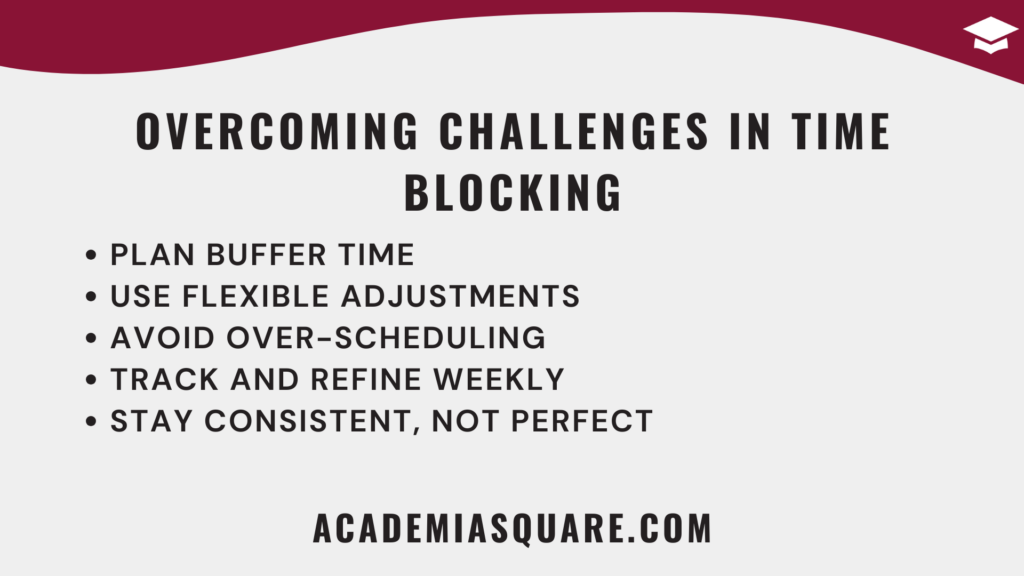
While time blocking offers significant benefits, implementing this strategy may present challenges that require proactive solutions:
- Overcommitment: Avoiding the temptation to allocate too many tasks within a limited time frame. Instead, prioritize essential tasks and allocate sufficient time for each.
- External Distractions: Minimizing interruptions during time blocks by setting boundaries, such as turning off notifications and finding a quiet study environment.
- Lack of Flexibility: Balancing the structured nature of time blocking with the need to adapt to unexpected changes or additional tasks that arise throughout the day.
- Procrastination: Breaking tasks into smaller, manageable blocks can help overcome procrastination tendencies and encourage steady progress.
- Time Management: Regularly reviewing and adjusting your time blocking schedule to ensure tasks are completed on time and to identify opportunities for improving efficiency.
- Motivation: Setting clear goals and rewards for completing tasks within designated time blocks can help maintain motivation and accountability.
By addressing these challenges proactively and refining your approach to time blocking over time, you can harness its full potential to enhance productivity, manage your academic workload effectively, and achieve your academic goals.
Time Blocking for Different Academic Tasks
Time blocking can be adapted to various academic tasks and responsibilities, providing a structured approach to managing your study sessions and enhancing productivity:
- Study Sessions: Allocate dedicated time blocks for different subjects or topics. For example, schedule specific blocks for reading textbooks, reviewing lecture notes, and practicing problem sets.
- Assignment Completion: Break down larger assignments into smaller tasks and assign time blocks for researching, outlining, drafting, and revising. This approach ensures steady progress and timely submission.
- Exam Preparation: Create focused study sessions leading up to exams. Dedicate time blocks for reviewing course materials, practicing past exams, and consolidating key concepts.
- Project Work: Manage group projects or research papers by assigning time blocks for brainstorming, collaboration meetings, individual research tasks, and drafting project components.
- Skill Development: Allocate time blocks for enhancing skills relevant to your academic and career goals, such as language learning, coding practice, or public speaking exercises.
By tailoring time blocking to specific academic tasks, you can maximize your efficiency, maintain focus on important priorities, and achieve academic success.
Example Time Blocking Schedules for Students
To put time blocking into action, it helps to see what a structured day looks like for different academic goals. Below are three realistic sample schedules based on common student scenarios: regular study sessions, exam preparation, and long-term skill development (such as learning a new language). Each schedule balances productivity with breaks, focus sessions, and personal time.
1. Study Session Schedule (General Coursework)
This schedule is designed for a typical school or university day where the goal is to stay on top of weekly assignments, readings, and classes. It balances deep work blocks with breaks and lighter tasks.
- 7:30 – 8:00 AM: Morning routine (breakfast, stretch, quick journaling)
- 8:00 – 9:00 AM: Reading & note-taking for one subject (deep work)
- 9:00 – 10:30 AM: Class or lecture block
- 10:30 – 10:45 AM: Short break (walk or snack)
- 10:45 – 12:00 PM: Assignment work (essay writing or problem sets)
- 12:00 – 1:00 PM: Lunch & rest
- 1:00 – 2:30 PM: Group project or discussion work
- 2:30 – 3:00 PM: Review flashcards or light revision (low-intensity)
- 3:00 – 4:00 PM: Leisure or exercise time
- 4:00 – 5:30 PM: Second study session: reading another subject
- Evening: Free time, dinner, and a light review session before bed (20–30 mins)
This structure supports focused academic work while avoiding burnout by spacing out cognitively demanding tasks and including personal downtime.
2. Exam Preparation Schedule
This schedule emphasizes deep focus and active recall, based on cognitive science principles like spaced repetition and retrieval practice — essential for effective exam prep.
- 7:00 – 7:30 AM: Wake up and light movement
- 7:30 – 8:30 AM: Flashcards or review of yesterday’s material
- 8:30 – 10:00 AM: Deep work block 1: Solve practice problems or write practice essays
- 10:00 – 10:15 AM: Break
- 10:15 – 11:45 AM: Deep work block 2: Review difficult topics using active recall
- 12:00 – 1:00 PM: Lunch and complete disengagement
- 1:00 – 2:30 PM: Timed quiz or mock exam simulation
- 2:30 – 3:00 PM: Debrief: correct mistakes, make summary notes
- 3:00 – 4:00 PM: Light review (watching review videos or listening to summary podcasts)
- 4:00 – 5:30 PM: Break or exercise
- 6:00 – 7:00 PM: Final recap session: brief flashcard review or memory dump
Research suggests that spreading revision throughout the day with varied formats (quizzes, summaries, retrieval) enhances memory consolidation better than massed cramming.
3. Skill Development Schedule (Language Learning)
This example shows how to integrate skill-building into a day, especially for students learning a second language. The idea is to expose yourself to the skill in different ways to engage multiple areas of the brain.
- 7:00 – 7:20 AM: Listening practice (news podcast or YouTube in target language)
- 8:00 – 9:00 AM: Grammar & vocabulary study using a textbook or app (e.g., Anki, Duolingo)
- 12:30 – 1:00 PM: Watch a short show or video segment with subtitles
- 3:00 – 4:00 PM: Speaking practice (tandem partner or self-recorded conversation practice)
- 5:00 – 5:30 PM: Writing practice: short journal entry, email, or paragraph in target language
- 8:30 – 9:00 PM: Reading short texts: news article, graded reader, or story
According to language acquisition research, consistent daily practice across listening, reading, speaking, and writing dramatically improves fluency retention. Blocking these modes into a balanced routine boosts long-term learning outcomes.
These sample schedules illustrate how adaptable time blocking can be. Whether your goal is academic consistency, high-stakes exam prep, or growing a skill, structured time management gives you control, reduces stress, and leads to better outcomes.
Advanced Time Blocking Techniques for Peak Productivity
For students seeking to elevate their productivity and efficiency, advanced time blocking techniques offer innovative strategies to optimize study habits and achieve peak performance:
Time Chunking
Time chunking involves dividing your day into larger blocks of time, such as morning, afternoon, and evening, and assigning specific themes or categories of tasks to each chunk. This method allows for flexibility within broader time frames while maintaining focus on the types of activities aligned with each designated period. For example, dedicating the morning chunk to intensive reading and research, the afternoon chunk to writing and assignments, and the evening chunk to review and reflection can optimize productivity by matching tasks to your energy levels throughout the day.
Theme Days
Theme days establish a structured routine by designating specific days of the week for different types of tasks or subjects. For instance, Mondays could be dedicated to math and science, while Wednesdays focus on language studies and essay writing. By grouping similar tasks together on designated days, students can minimize mental context switching and maintain a consistent focus on specific areas of study, enhancing overall productivity and depth of learning.
Power Hours
Identifying your peak productivity hours, often characterized by higher energy levels and enhanced concentration, allows for scheduling intensive study sessions during these times. Whether you’re a morning person or perform best in the late afternoon, leveraging your natural rhythms can maximize the effectiveness of your study blocks. Power hours enable focused work on challenging tasks or priority assignments, ensuring optimal performance and efficient use of peak cognitive abilities.
Task Batching
Task batching involves grouping similar tasks or activities together within a single time block to streamline workflow and minimize interruptions. For example, combining reading assignments, note-taking, and summarizing into one session allows students to maintain momentum and cognitive flow, reducing the time spent transitioning between different types of tasks. By consolidating related activities, task batching enhances efficiency and supports sustained concentration throughout the study session.
Reverse Engineering
Reverse engineering begins with defining your desired outcome or goal and then working backward to allocate time blocks for the necessary tasks and milestones. This strategic approach ensures clarity of purpose and effective time allocation by focusing on the specific actions required to achieve desired academic outcomes. By breaking down long-term objectives into manageable steps and assigning dedicated time blocks to each phase of the process, students can maintain motivation, track progress, and successfully accomplish their academic goals.
Time Blocking for Energy Levels
Adapt time blocking to align with your natural energy levels throughout the day. Schedule mentally demanding tasks during periods of peak alertness and reserve low-energy times for lighter activities like reviewing notes or organizing study materials. Matching tasks to your energy levels can enhance efficiency and prevent burnout, ensuring consistent productivity over extended study sessions.
Time Blocking for Distraction Management
Implement time blocking to manage distractions effectively by creating dedicated blocks of time for focused work. Set clear boundaries, such as turning off notifications, finding a quiet study space, and using productivity tools like the Pomodoro Technique within time blocks to maintain concentration and minimize interruptions. By proactively managing distractions, students can optimize study sessions and improve overall productivity.
Integrating Breaks and Restorative Activities
Integrate regular breaks and restorative activities into your time blocking schedule to maintain mental and physical well-being. Schedule short breaks between intensive study sessions to recharge and prevent mental fatigue. Incorporate activities like exercise, meditation, or hobbies into longer breaks to rejuvenate focus and enhance overall productivity throughout the day.
Priority-Based Time Blocking
Prioritize tasks based on importance and deadlines when allocating time blocks. Identify critical tasks that contribute significantly to academic goals and allocate dedicated time blocks for their completion. Use techniques such as Eisenhower’s Urgent/Important Principle to categorize tasks and ensure that time blocks align with strategic priorities, optimizing productivity and progress toward achieving academic objectives.
These advanced time blocking techniques provide students with versatile strategies to customize their study routines, enhance productivity, and achieve academic success through effective time management and focused work habits.
Conclusion: Mastering Your Time, Elevating Your Results
Time blocking is more than just a scheduling technique — it’s a mindset shift that empowers you to take full ownership of your time, attention, and academic progress. By breaking your day into intentional blocks and aligning those blocks with your goals, you turn vague ambitions into concrete, actionable plans.
Throughout this guide, we’ve explored the fundamentals of time blocking, how to implement it in your study routine, and the variety of methods you can tailor to your needs — from fixed and flexible blocks to deep work and skill development strategies. Each method provides a unique approach to improving focus, minimizing distractions, and maximizing productivity. The key takeaway is that there’s no one-size-fits-all system. The best time-blocking strategy is the one that evolves with you.
The example schedules provided give you a practical starting point, whether you’re navigating a typical study day, preparing for an intense exam period, or working steadily on long-term goals like learning a new language. Remember, consistency is more powerful than intensity. Even small, well-structured time blocks practiced daily can lead to meaningful progress.
Ultimately, time blocking isn’t just about doing more — it’s about doing what matters most, with clarity and intention. In a world filled with constant distractions and shifting priorities, a well-crafted schedule becomes a personal roadmap to success. So start small, stay flexible, and make reflection part of your process.
Adopt time blocking not as a strict regime, but as a flexible framework that supports your learning, mental well-being, and growth. With each block of focused time, you’re not just getting tasks done — you’re building the discipline and momentum that lead to lasting academic success.
FAQs – Time Blocking for Students
What is time blocking and how does it improve productivity?
Time blocking is a time management method where your day is divided into blocks dedicated to specific tasks. According to a study published in the journal *Cognitive Technology*, structured scheduling like time blocking significantly reduces procrastination and cognitive overload, improving focus and task completion.
Is time blocking effective for students with irregular schedules?
Yes. Flexible time blocking adapts to shifting classes, deadlines, and extracurriculars. A 2022 study in *Educational Psychology Review* suggests that adaptive planning techniques help students maintain higher productivity and lower stress even with fluctuating routines.
How do I start time blocking if I’ve never used a planner before?
Start by tracking your current time use for a few days, then identify your most important academic tasks. Use a digital or paper planner to assign blocks to these tasks. Begin with just 2–3 blocks per day. Studies show that habit formation improves with low-barrier entry points and routine cues.
How long should each time block be?
Ideal time blocks range from 30 to 90 minutes depending on task complexity and personal focus span. Research from the University of California, Irvine, found that it takes an average of 23 minutes to regain focus after a distraction—so uninterrupted blocks are crucial for deep work.
Can time blocking reduce academic stress?
Yes. Time blocking gives students control over their schedule, reducing uncertainty and decision fatigue. A study in the *Journal of College Student Development* linked structured time management techniques with lower stress and higher academic confidence.
What’s the difference between time blocking and a traditional to-do list?
While a to-do list tells you what to do, time blocking tells you when to do it. According to productivity expert Cal Newport, time blocking forces you to engage in “deep work” by reducing decision-making and distractions tied to unstructured task lists.
Should breaks be scheduled into time blocks?
Absolutely. Breaks are essential to prevent mental fatigue. The Pomodoro Technique, for example, incorporates 5-minute breaks after 25-minute work sessions. Research from the NIH confirms that strategic rest enhances cognitive function and learning retention.
Is digital or paper time blocking more effective?
Both are effective; the best choice depends on personal preference. A study from *Psychological Science* suggests that writing by hand improves memory retention, while digital tools offer automation and integration with reminders, making them ideal for busy schedules.
Can I time block extracurricular or personal goals?
Yes. Time blocking can be applied to workouts, hobbies, volunteering, or rest. Research from the *Journal of Positive Psychology* indicates that scheduling leisure boosts well-being and increases follow-through on non-academic goals.
What tools help with time blocking?
Google Calendar, Notion, Trello, and apps like Sunsama or Motion are popular for time blocking. Many offer templates and drag-and-drop features for visual scheduling. Research shows that visual time representation helps with time awareness and task commitment.
How often should I review and adjust my time blocks?
A weekly review is ideal. According to the productivity system GTD (Getting Things Done), regular reflection helps identify bottlenecks and re-align blocks with shifting priorities. This keeps your system effective and avoids burnout.
Is it okay to miss or reschedule a time block?
Yes. Time blocking is a flexible tool, not a rigid rule. Occasional rescheduling is normal. Just be sure to reschedule, not delete. Behavioral economist Dan Ariely notes that rescheduling sustains momentum and maintains a sense of control.
Sources and Recommended Reading on Time Blocking and Productivity
- Britton, Bruce K., and Tesser, Abraham. “Effects of Time-Management Practices on College Grades.” SAGE Open, 2019.
- Harvard University Academic Resource Center. “Time Management Strategies for Students.”
- American Psychological Association. “Multitasking: Switching Costs and Productivity.”
- SAGE Journals. “Starting Your Day with Dread or Excitement? The Effects of Meeting Load on Anticipated Affect and Productivity.”
- University of Pennsylvania. “Mastering Your Schedule: Effective Time Management Strategies for Success.”
- American Psychological Association. “Boosting Productivity: Strategies for Focus and Efficiency.”
- SAGE Research Methods. “Six Academic Writing Habits That Boost Productivity.”
- Georgetown University. “A Slower Way to Amp Up Your Productivity.”
- Stanford University. “Getting Things Done: Strategies and Digital Tools for Time and Tasks.”
- Harvard Summer School. “8 Time Management Tips for Students.”
- SAGE Journals. “Time Management Strategies for Research Productivity.”
- American Psychological Association. “Time Management Activity for Students.”
- SAGE Research Methods. “Calendar and Time Diary: Methods in Life Course Research.”


